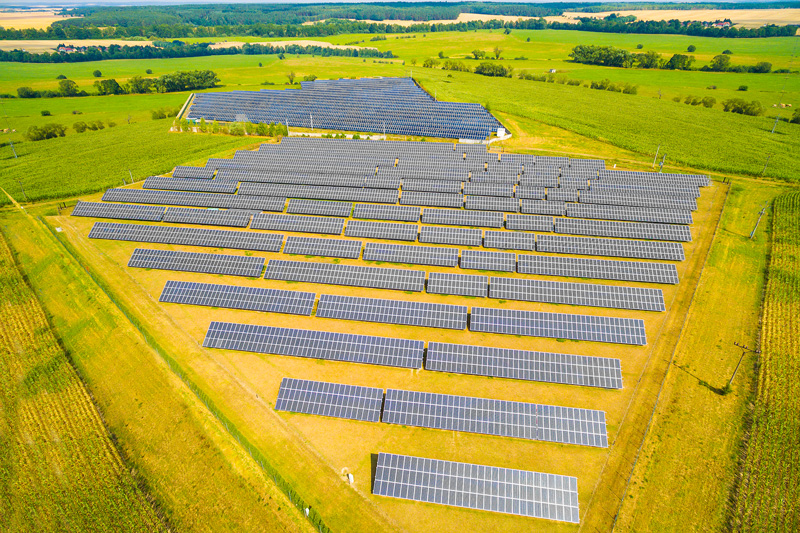


More power from the sun
Photo by iStock September 23, 2020
New solar-cell design shows potential for increased efficiency
A collaborative research team, consisting of University of Delaware mathematicians and engineers at Pennsylvania State University, has come up with a new design for thin-film solar cells with the potential to significantly increase the efficiency of these flexible panels that convert sunlight into electricity.
Solar energy has long been recognized as an important renewable resource to lessen our dependence on fossil fuels. Solar cell technology has continually improved, with scientists and engineers seeking to enhance such factors as efficiency, affordability, ease of installation and flexibility of uses.
But finding the right balance of those factors has been a challenge.
For example, standard solar cells, the kind seen on rooftops and in “farms” spread over acres of land, are reasonably efficient and increasingly affordable, but they are heavy and rigid. Thin-film cells — built from lightweight and flexible materials, making them useful for such applications as portable devices and vehicle roofs — are inexpensive and easy to manufacture, but they are much less efficient at converting light into power. Specialized types of thin-film technology are more efficient, but those cells are manufactured from expensive materials or are not long-lasting, severely limiting their use.
“We wanted to find a way to increase the efficiency of thin film devices, with a long life but without making the cells too thick or too expensive,” said Peter Monk, Unidel Professor of Mathematics at UD, who worked with Faiz Ahmad and Akhlesh Lakhtakia from Penn State and Tom Anderson and Benjamin Civiletti at UD on a multi-year research project funded by the National Science Foundation (NSF). “The key is to predict how light gets into the solar cell, how to keep it there and how to convert it efficiently into electricity. We designed a computer simulation to let us predict the energy-conversion efficiency.”
Their findings were published recently in the journal Applied Physics Letter and led to a new NSF grant to continue the work.
A photovoltaic solar cell consists of absorber (semiconductor) layers that take in photons from the sun and use the energy to promote electrons from the bound valence band to the conduction band of the material. These mobile electrons that have jumped into the conduction band can then create a current. Other materials in the cell include, for example, a metallic reflective layer and a special anti-reflective top coating to help light enter the device.
In the new research findings, the team proposed a cell with absorber layers consisting of two materials instead of the usual single layer. Mathematical computer models designed by Monk, postdoctoral researcher Tom Anderson and graduate student Benjamin Civiletti at UD, and the Penn State group yielded precise specifications for the layers, which resulted in an expected power-conversion efficiency rate of 34%.
“A standard solar cell on a roof can have an efficiency of about 27%, and the efficiency of thin film can be in the low 20s, or even less,” Monk said. “So 34% is a very large increase in efficiency.”
The proposed design is based on computer simulations, he pointed out, and hasn’t yet been manufactured.
“We’ve tested all our mathematical models, but it needs to be built to be certain of the efficiency rate,” Monk said. “We’re trying to interest people in doing that, but it’s probably a multi-year, multi-million-dollar endeavor.”
Meanwhile, the researchers plan to continue their work, hoping to improve the computer models they used and to create a design that’s easier to manufacture, including the addition of more complex antireflection coatings to better trap the energy absorbed from light.
The NSF awarded them a new three-year grant in August that will fund two postdoctoral researchers, one at UD and one at Penn State.
More about Peter Monk
Monk, who joined the UD Department of Mathematical Sciences faculty in 1982, conducts research in numerical analysis and scientific computing, with particular emphasis on numerical methods in computational electromagnetism and inverse scattering.
His computer modeling simulations in the solar cell research relied on a set of differential equations known as Maxwell’s equations, together with a model for charge transport. These equations describe how electric and magnetic fields propagate and how mobile electrons move in the device.
One key to the most recent research, Monk said, is to take the simulation tool that’s been developed based on those equations and use it to explore a variety of possible solar-cell materials and their optical and electrical properties.
Contact Us
Have a UDaily story idea?
Contact us at ocm@udel.edu
Members of the press
Contact us at 302-831-NEWS or visit the Media Relations website

